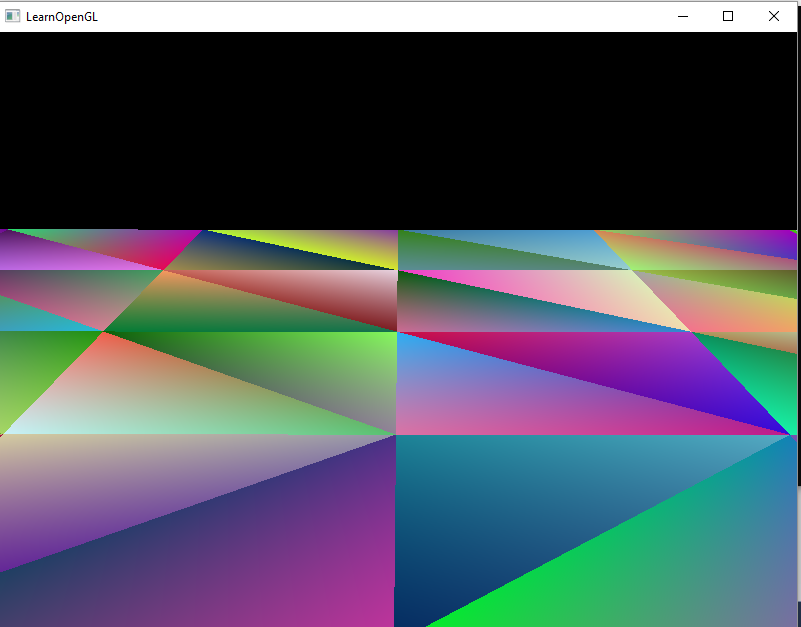I have rewritten this function a few times now and I am having trouble getting every other row to have the triangles face the reverse direction. The image enclosed demonstrates the faulty behavior which includes only one row facing the reversed direction.
I am also confused by how many indexes I should have for the g_vertex_buffer_data_land variable, could someone show me a breakdown like : 18 vertices times 2 sets times 8 columns times 8 depth.
In another post fleabay mentioned I was not setting a VAO in core profile, however It seems to be.
here is the code:
float* getVertices(void) {
//using defines
int incol = _colus;
int depth = _depth;
int i = 0;
float scaleit = .5;
float tempdepth = 0;
int startindexat = 0;
int counter = 0;
int secondcounter = 0;
//for (; (tempdepth+1) <= (depth);)
//don't forget to change this back!
for (int q=0;q<3;q++)
{
//odd rows
for (int col = 0; (col+1) <= (incol ); col++)
{
GLfloat matrix1[3][3] = { {(col + 1),0,(tempdepth)},{ (col),0,(tempdepth)}, {(col),0,(tempdepth + 1) } };
// //vertex 1
g_vertex_buffer_data_land[startindexat + 0 + counter] = matrix1[0][0] * scaleit;
g_vertex_buffer_data_land[startindexat + 1 + counter] = matrix1[0][1] * scaleit;
g_vertex_buffer_data_land[startindexat + 2 + counter] = matrix1[0][2] * scaleit;
//vertex 2
g_vertex_buffer_data_land[startindexat + 3 + counter] = matrix1[1][0] * scaleit;
g_vertex_buffer_data_land[startindexat + 4 + counter] = matrix1[1][1] * scaleit;
g_vertex_buffer_data_land[startindexat + 5 + counter] = matrix1[1][2] * scaleit;
g_vertex_buffer_data_land[startindexat + 6 + counter] = matrix1[2][0] * scaleit;
g_vertex_buffer_data_land[startindexat + 7 + counter] = matrix1[2][1] * scaleit;
g_vertex_buffer_data_land[startindexat + 8 + counter] = matrix1[2][2] * scaleit;
int matrix2[3][3] = { { (col + 1),0,(tempdepth + 1)},{ (col + 1),0,(tempdepth)}, {(col),0,(tempdepth + 1) } };
g_vertex_buffer_data_land[startindexat + 9 + counter] = matrix2[0][0] * scaleit;
g_vertex_buffer_data_land[startindexat + 10 + counter] = matrix2[0][1] * scaleit;
g_vertex_buffer_data_land[startindexat + 11 + counter] = matrix2[0][2] * scaleit;
g_vertex_buffer_data_land[startindexat + 12 + counter] = matrix2[1][0] * scaleit;
g_vertex_buffer_data_land[startindexat + 13 + counter] = matrix2[1][1] * scaleit;
g_vertex_buffer_data_land[startindexat + 14 + counter] = matrix2[1][2] * scaleit;
g_vertex_buffer_data_land[startindexat + 15 + counter] = matrix2[2][0] * scaleit;
g_vertex_buffer_data_land[startindexat + 16 + counter] = matrix2[2][1] * scaleit;
g_vertex_buffer_data_land[startindexat + 17 + counter] = matrix2[2][2] * scaleit;
counter = counter + 18;
}//end col
startindexat = 17 + counter+ 1;
for (int col2 = 0; (col2+1) <= (incol); col2++)
{
//first triangle : even rows
GLfloat matrix3[3][3] = { {(col2 + 1) ,0,(tempdepth + 2)} , {(col2 + 1),0,(tempdepth + 1)}, {(col2),0,(tempdepth +1)} };
// //vertex 1
g_vertex_buffer_data_land[(startindexat + secondcounter)] = matrix3[0][0] * scaleit;
g_vertex_buffer_data_land[(startindexat + 1 + secondcounter)] = matrix3[0][1] * scaleit;
g_vertex_buffer_data_land[(startindexat + 2 + secondcounter)] = matrix3[0][2] * scaleit;
//vertex 2
g_vertex_buffer_data_land[(startindexat + 3 + secondcounter)] = matrix3[1][0] * scaleit;
g_vertex_buffer_data_land[(startindexat + 4 + secondcounter)] = matrix3[1][1] * scaleit;
g_vertex_buffer_data_land[(startindexat + 5 + secondcounter)] = matrix3[1][2] * scaleit;
g_vertex_buffer_data_land[(startindexat + 6 + secondcounter)] = matrix3[2][0] * scaleit;
g_vertex_buffer_data_land[(startindexat + 7 + secondcounter)] = matrix3[2][1] * scaleit;
g_vertex_buffer_data_land[(startindexat + 8 + secondcounter)] = matrix3[2][2] * scaleit;
// even (2)
int matrix4[3][3] = { {(col2 + 1),0,(tempdepth+ 2)},{ (col2),0,(tempdepth+ 1)}, {(col2),0,(tempdepth + 2) } };
g_vertex_buffer_data_land[(startindexat+9 + secondcounter)] = matrix4[0][0] * scaleit;
g_vertex_buffer_data_land[(startindexat+10 + secondcounter)] = matrix4[0][1] * scaleit;
g_vertex_buffer_data_land[(startindexat+11 + secondcounter)] = matrix4[0][2] * scaleit;
g_vertex_buffer_data_land[(startindexat+12 + secondcounter)] = matrix4[1][0] * scaleit;
g_vertex_buffer_data_land[(startindexat+13 + secondcounter)] = matrix4[1][1] * scaleit;
g_vertex_buffer_data_land[(startindexat+14 + secondcounter)] = matrix4[1][2] * scaleit;
g_vertex_buffer_data_land[(startindexat+15 + secondcounter)] = matrix4[2][0] * scaleit;
g_vertex_buffer_data_land[(startindexat+16 + secondcounter)] = matrix4[2][1] * scaleit;
g_vertex_buffer_data_land[(startindexat+17 + secondcounter)] = matrix4[2][2] * scaleit;
//one column of 4 triangles
//(three vetices per triangle)
secondcounter = secondcounter + 18;
}
startindexat = 17 + secondcounter + 1;
tempdepth = tempdepth - 1;
}
return gvertices;
}
I am hoping someone might have the experience to help me solve this problem. Or, what could I check and do I need to show more repo code?
Thank you,
Josheir











